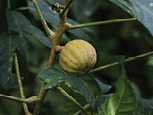Return to 1st Quarter 2019 articles.



Plants use a wide range of methods to spread their seeds. Some plants have seeds encased in a shell or a fleshy bundle that various animals, including humans, like to eat. We are all familiar with nuts and fruits, but the basic design of these foods is to spread their seeds. We live in an area where poison ivy is a real nuisance, and getting rid of it this year will not stop it from being a problem next year because birds eat the berries and replant the ivy all over our property. For good or bad, plants spread their seeds.
Plants that shoot their seeds use one of the most interesting methods of seed disbursal. The seed pod in the picture is from the sandbox tree (Hura crepitans) nicknamed “the dynamite tree” because of the explosive way the pods burst open. In the segments of the pod, the outer and inner layers grow at different speeds. This creates tension as the surfaces push against each other. When the seeds are ready, the pressure becomes so great, that the capsule explodes. The sections that were initially convex rapidly flip to concave in a process known to engineers as snap-buckling. That explosion can shoot the seeds 100 feet (30 meters) at speeds of 160 miles (257 kilometers) per hour.
Some of us remember “jumping disks” we had as children. Two metals were fused together with the metals having different coefficients of linear expansion. If you rubbed the side of the disk with your finger making it warm, it would expand, and you could bend it, so the disk had tension produced and held by the expanded metal. As the disk cooled, it would eventually snap back to its original shape, causing it to jump into the air.
Measurements of snapping plants show a g-force of 2400. Fighter pilots can handle about nine gs before passing out. A wide variety of designs allow plants to shoot seeds or snap shut to trap food.
Plants spread their seeds by many amazing mechanisms God has built into them, and which scientists are still trying to understand.
Picture credits:
© eriksvoboda. Image from BigStock.com.
https://upload.wikimedia.org/wikipedia/commons/f/f2/Hura_crepitans_%28fruit%29.jpg
